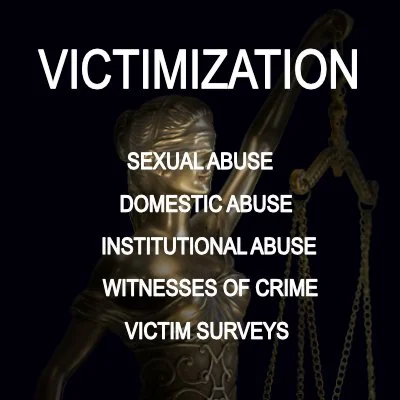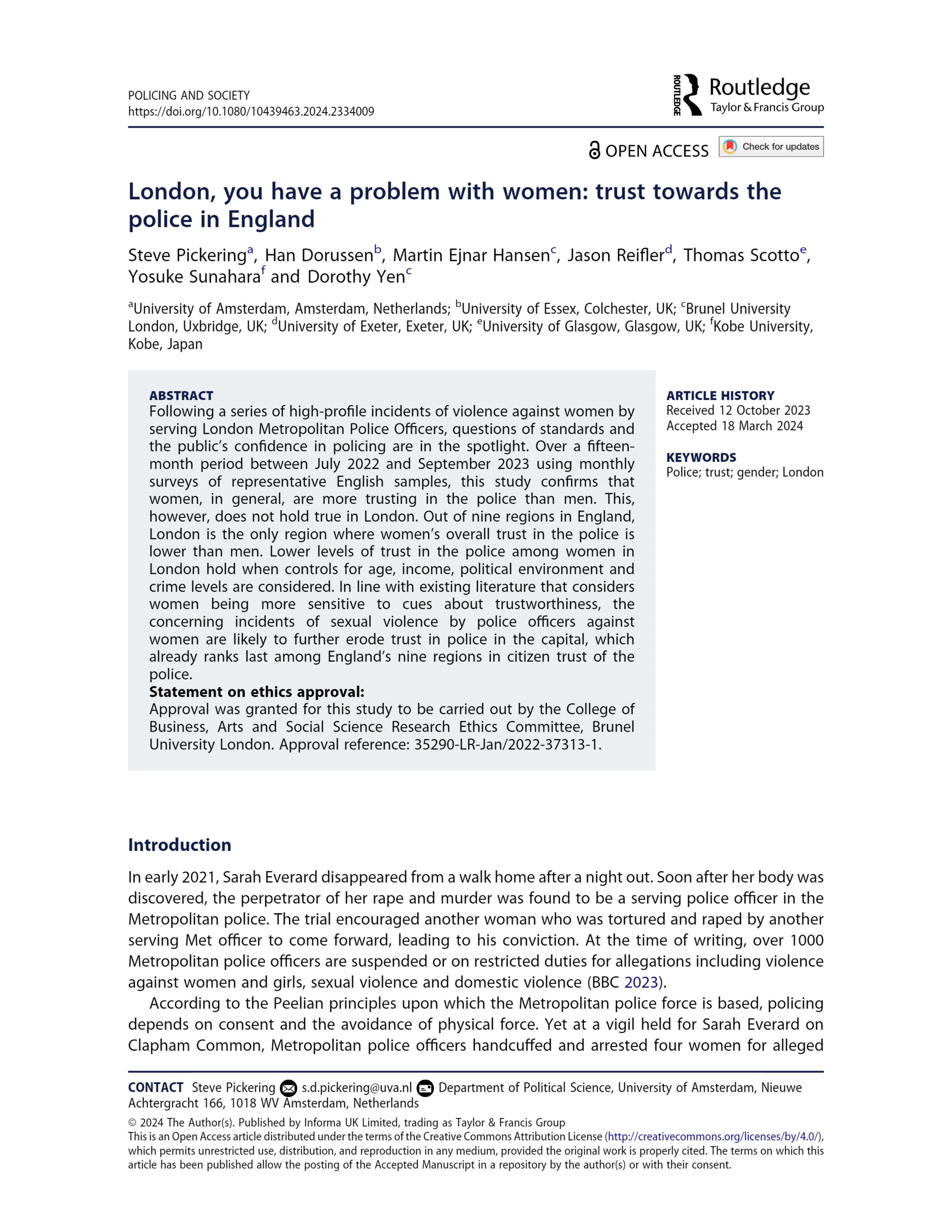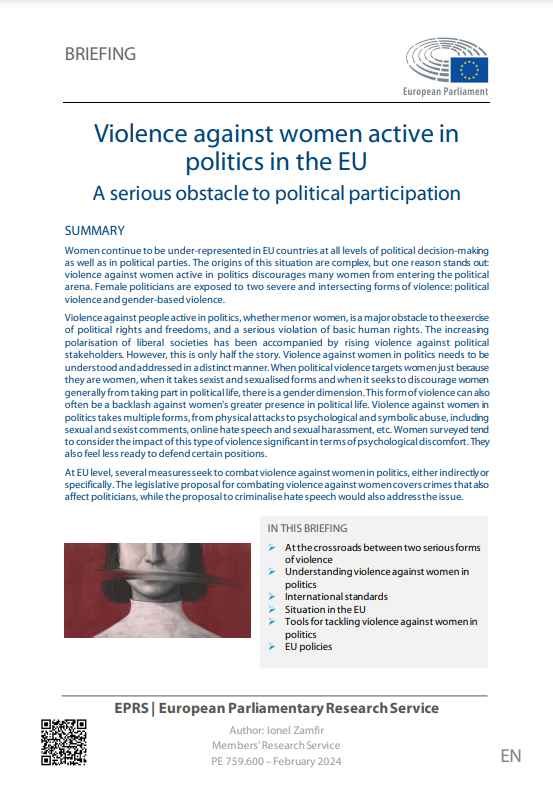By Greg Hannah, Caroline Harper, Heather James and Grace Whitehead, under the direction of Oliver Lodge.
Definitions of the term ‘violence against women and girls’ (VAWG) vary, but the government defines it as “acts of violence or abuse that we know disproportionately affect women and girls”. It covers crimes including rape and other sexual offences, stalking, domestic abuse, ‘honour’-based abuse (including female genital mutilation, forced marriage and ‘honour’ killings), ‘revenge porn’ and ‘upskirting’. Over one in four women are estimated to be victims of sexual assault or attempted assault in their lifetime, and one in 12 women are victims of VAWG each year, although the actual number is likely to be much higher. The National Police Chiefs’ Council reported that, in 2022-23, 20% of all police-recorded crime was related to violence against women and girls. The victim was female in 86% of all police-recorded sexual offences in the year to March 2022. In the year ending December 2023, over 97% (23,723) of people convicted of sexual offences were male, and crimes are often committed by someone known to the victim. 3 Violence against women and girls can have long-term impacts on victims, affecting them physically, mentally, socially and financially. It is estimated that the economic and social cost of domestic abuse could be as high as £84 billion. The Home Office last estimated the societal cost of rape cases in 2018, based on 2015-16 data, when it estimated that the 122,000 rape cases reported that year could have a societal cost of around £4.8 billion. In 2021, the then government introduced its strategy, “Tackling Violence Against Women and Girls” (the VAWG Strategy), which outlined a series of commitments focused on: • prevention – to deliver long-term cultural and societal change; • supporting victims – to increase support for victims and survivors including providing support services that are run by and for the communities they serve; • pursuing perpetrators – to transform the criminal justice response to ensure all perpetrators of offences against women are brought to justice; and • building a stronger system – working with multiple government departments to develop a joined-up system across health, justice, law enforcement, housing, social care and education. In 2021, the Domestic Abuse Act received Royal Assent, and in 2022 the Home Office published a separate “Tackling Domestic Abuse” Plan (the Domestic Abuse Plan) The Home Office leads on the government’s response to tackling VAWG, including domestic abuse. However, achieving progress requires the commitment of multiple government departments. There are important roles for the Ministry of Housing, Communities and Local Government, the Ministry of Justice and other parts of the criminal justice system, the Department for Education and NHS England in, for example, identifying victims and supporting them to feel safe, educating young people in safe relationships and ensuring justice through the courts and prison systems. The new government has committed to halve the prevalence of VAWG within a decade as part of its ‘mission’ to make streets safer. The Home Office will lead this mission and is developing a new VAWG strategy. In this report, we have examined the Home Office’s leadership of the 2021 “Tackling Violence Against Women and Girls” Strategy (the VAWG Strategy) and the 2022 “Tackling Domestic Abuse Plan” (the Domestic Abuse Plan), to identify lessons to support the delivery of the government’s ambition to halve violence against women and girls. Key Findings Progress against the 2021 strategy Violence against women and girls is a serious and growing problem. In 2023-24 the prevalence of sexual assault against women aged 16 to 59 in England and Wales (the percentage of the population estimated to have suffered a sexual assault each year) was higher than in 2009-10 (4.3% and 3.4% respectively). Conversely, the prevalence of domestic abuse against women was lower (9.2% and 7.4% respectively). Over the same period incidents of rape and sexual assault against women and girls recorded by police have increased almost fourfold, from 34,000 to 123,000, although this can in part be explained by improved recording of these crimes. The societal landscape against which these crimes are committed has also become increasingly complex and in recent years online harms (such as revenge porn) have been recognised as crimes in themselves (paragraphs 1.2, 1.4, 1.7 to 1.9 and Figures 1 and 2). 8 To date, the Home Office has not led an effective whole-system response. Successfully addressing the harms caused by VAWG requires the coordinated effort and commitment of many government departments. But the cross-departmental governance in place did not ensure all departments were prioritising the VAWG Strategy’s aims and were pulling in the same direction. The Home Office created a dedicated team to lead the VAWG Strategy, but it has found it challenging to get buy-in from other government departments. The Home Office’s Officials’ oversight group, established to progress the Strategy, did not meet until a year after the VAWG Strategy’s launch. The Home Office has since revised its governance, which has been welcomed by some departments. While strong ministerial support can encourage cross-government working, the Ministerial oversight group for the VAWG Strategy only met four times in three years (paragraphs 1.10, 3.4 to 3.8). 9 The Home Office has not had a full understanding of the scale of resources committed to tackling VAWG across government, limiting its ability to prioritise efforts. As the lead department for tackling VAWG, the Home Office needs to understand the capacity and resources other bodies are committing to the VAWG Strategy so it can effectively coordinate and oversee their work. The Home Office has not centrally coordinated funding for VAWG across government and, in contrast with the 2021 illegal drugs strategy, the relevant departments did not prepare a joint spending review bid during the period of implementing the VAWG Strategy. Our analysis suggests other government departments spent at least £979 million between 2021-22 and 2023-24. The Home Office has historically underspent its own budget allocated to the VAWG Strategy, by an average of 15% between 2021-22 and 2023-24 (paragraphs 2.5 to 2.9 and Figure 7). The lack of a consistent definition for VAWG across public bodies and their approaches to measuring the scale of VAWG crimes has made it difficult to measure progress in a consistent way. The Home Office’s definition of VAWG includes all victims, across all ages and genders, whereas police forces only include women and girls. The Home Office told us it uses estimates from the Crime Survey for England and Wales to measure prevalence, which does not include children under the age of 16, even though they are included in the Strategy. The Home Office does not consider police-recorded crime an accurate indicator of the prevalence of VAWG, since it is likely to under-report crimes: the police only record one crime per victim/perpetrator relationship, even where multiple VAWG crimes are committed. This, in addition to gaps in data for some VAWG crime types such as ‘honour’-based abuse, limits the data available to measure progress. A consistent definition and approach to measuring the scale of VAWG crimes across all of government and policing would help to create a better shared understanding of the scale of the challenge the government is trying to address (paragraphs 3.16 to 3.21 and Figure 12).
London: National Audit Office, 2025. 69p.

















